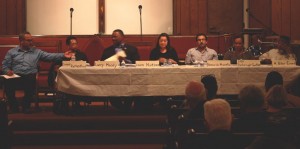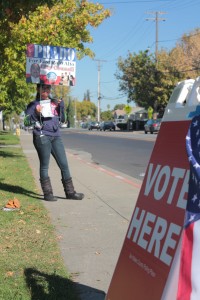To learn more about this story and how it developed, listen to the Peninsula Report podcast.

This article was updated on Nov. 29 to reflect the final election results.
When voters elected East Palo Alto’s first majority-Latino City Council in 2008, the political landscape finally caught up to a demographic shift that had happened a decade earlier.
But those gains have yet to solidify. This week, the San Mateo County Elections Office certified the outcome of the Nov. 6 council race, with the final tally returning an African-American majority to the five-member board. The city’s population is nearly 65 percent Latino.
Voters elected Laura Martinez, the current mayor and a Latina, as well as Larry Moody and Lisa Yarbrough-Gauthier, both first-time candidates who are African-American. They join council members Ruben Abrica and David E. Woods, elected in 2010.
When Martinez and Carlos Romero, who did not run again this year, were elected to the council four years ago, they joined Abrica in forming the first Latino majority in the city’s history. Though East Palo Alto has had a majority Latino population since the late 1990s, Abrica was until that point the only Latino council member. He first served from 1983 to 1988 and joined the council again in 2004 after William C. Woodard resigned.
Since the city’s incorporation in 1983, African-Americans have been elected in dominant numbers. Besides Abrica, Martinez and Romero, the only non-black council member was Duane Bay, who served two terms from 1996 to 2004. In an interview one week before the election, Bay, who is Caucasian, acknowledged that while “not fundamental” to campaigns, “race definitely has a strong influence on the local politics.”

That is perhaps inevitable in a city that has seen a radical demographic shift over the course of its short existence.
In the 1980s, African-Americans made up a majority of East Palo Alto residents. The Latino population has since exploded from fewer than 15 percent when the city formed to the nearly two-thirds majority in 2010, according to Census data. Over three decades, the African-American population fell from about 60 percent to 16.7 percent.
In interviews with the field of council candidates, several noted that the changing demographics have frequently been a source of tension and distrust between the two communities, particularly as they seek political clout. Moody called it “an internal infighting that shouldn’t be,” adding that what is good for the city is good for all residents.
But there are still Latino community members who worry that their representation continues to lag, despite more than a decade of majority population status. These include Bernardo Huerta, who said Latino voices have been missing in important decisions regarding land use and housing improvements, and Abrica, who has pushed to increase Latinos’ presence in local politics for many years.
In 1990, voters elected Abrica to the Ravenswood City School District board, making him the first Latino on an otherwise African-American board, even as the student body became majority Latino. Today, about 80 percent of students in East Palo Alto are Latino, as are four of the five school board members.
Abrica said he recruited Martinez and Romero to run for City Council in 2008. “It’s time” to have more Latinos on the council, he added, to advocate for the needs of Latino residents on issues like housing and law enforcement.

While there is no guarantee that more Latino voters would elect more Latino candidates to the council, they have been historically underrepresented in the East Palo Alto voting population for several reasons, including citizenship status and language barriers.
Nearly a third of residents are not naturalized citizens, according to the U.S. Census Bureau’s 2010 American Community Survey (ACS), meaning they cannot fully engage in the political process. The overwhelming majority of these immigrants are from Latin America, although East Palo Alto is also home to an emerging Pacific Islander community, now 7.5 percent of the population, which has not been represented on the council.
Huerta, a resident of East Palo Alto for nearly 50 years, said that a more cooperative relationship with law enforcement and a more affordable standard of living likely attracted the many new Latino residents who have come in recent decades.
Language differences also create a barrier for many Latinos who wish to participate in elections. According to the ACS, about 57 percent of the East Palo Alto population speaks Spanish at home. Of these residents, fewer than half speak English “very well.”
“A lot of times those folks get left out,” said Martinez, the mayor. During her term on the council, she has made an effort to bridge the information gap by holding committee meetings for Spanish-speaking families, she added.
The situation is not unique to East Palo Alto, according to Jennifer Martinez with Peninsula Interfaith Action, a faith-based community organizing group. Latinos have disproportionately low turnout rates in elections at every level, she said. As a result, they are often overlooked by campaigns that target their messages at likely voters, resulting in a lack of political education that leads to further disengagement and marginalization, she said.
This fall, Jennifer Martinez and her group canvassed East Palo Alto to encourage Latino residents to get out to the polls. She hoped to inspire greater and more frequent voting in the Latino community, motivated by social justice issues such as access to housing, health care and education.
“We see it as a longer term change that we want to create in the state,” Jennifer Martinez said. “This is likely to take a long time.”

Most of the candidates and council members interviewed, however, maintained that East Palo Alto residents are united more by their concern for the city than divided by their differences.
“Poverty has no color scheme,” Moody said. “However the city votes, these new leaders have a responsibility to serve the whole community.”
That philosophy was on display at a candidates forum on Oct. 29, at the Faith Missionary Baptist Church of Christ, the week before the election. All seven hopefuls emphasized similar platforms: job creation in a city with few small businesses of its own, affordable housing amidst the rising living expenses of the Silicon Valley, and increased safety for a community still wounded by gang warfare and the nation’s highest murder rate in the 1990s.
“As long as people can work together, it doesn’t matter what community they’re from,” Yarbrough-Gauthier told the Peninsula Press. “We’re one city and we have to act as one city.”
Peninsula Press staff writers Rachel Estabrook and Xiaohuo Cui contributed to this report.
[soundcloud url=”http://api.soundcloud.com/tracks/70017788″ params=”?” width=” 100%” height=”166″ iframe=”false” /]
